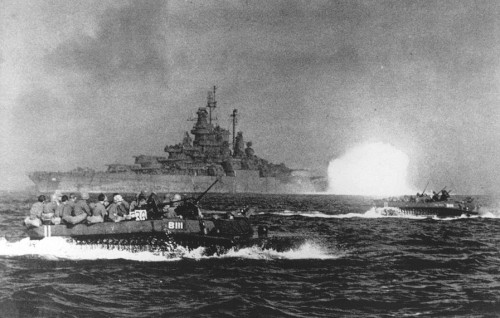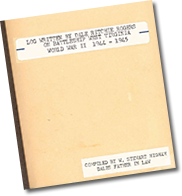View larger map
Joining TF 64 for the invasion of the Okinawa Gunto area, West Virginia sailed on March 21, reaching her objective four days later on the 25th. In fire support section one, West Virginia spent the ensuing days softening up Okinawa for the American landings slated to commence on April l. At 1029 on March 26, lookouts reported a gun flash from shore, followed by a splash in the water some 6,000 yards off the port bow. Firing her first salvoes of the operation, West Virginia let fly 28 rounds of 16- inch gunfire against the pugnacious Japanese batteries.
The following day, the “Wee Vee” fought against enemy air opposition, taking a “Frances” under fire at 0520. The twin-engined bomber crashed off the battleship’s port quarter–the victim of West Virginia’s anti-aircraft guns. Over the days that followed, enemy opposition continued in the form of suicide attacks by Japanese planes. Mines, too, began making themselves felt; one sank the minesweeper Skylark (AM-68), 3,000 yards off West Virginia’s port bow at 0930 on the 28th.
After taking on ammunition at Kerama Retto–the island seized to provide an advance base for the armada massing against Okinawa– West Virginia sailed for Okinawa to give direct gunfire support to the landings. Scheduled to fire at 0680, the battleship headed for her assigned zone off the Okinawa beaches. While en route, though, at 0455, she had to back down all engines when an unidentified destroyer stood across her bow, thus avoiding a collision.
As she prepared to commence her bombardment, West Virginia spotted a Japanese plane off her port quarter her antiaircraft batteries tracked the target and opened fire, downing the enemy aircraft 200 yards away. Four more enemy planes passed within her vicinity soon thereafter–West Virginia claimed one of them.
Finally, at 0630, West Virginia opened fire as landing craft dotted the sea as far as the eye could reach, all heading for the shores of Okinawa. West Virginia’ssailors, some 900 yards off the beaches, could see the craft heading shoreward like hundreds of tadpoles; at 0842, lookouts reported seeing some of the first troops going ashore. The battle for Okinawa was underway.
West Virginia continued her bombardment duties throughout the day, on the alert to provide counter-battery fire in support of the troops as they advanced rapidly inland. There appeared to be little resistance on April 1, and West Virginia lay to offshore, awaiting further orders. At 1903, however, an enemy plane brought the war down on West Virginia.
The battleship picked up three enemy planes on her radar and tracked them as they approached; flak peppered the skies but still they came. One crossed over the port side and then looped over and crash-dived into West Virginia, smashing into a superstructure deck just forward of secondary battery director number two. Four men were killed by the blast, and seven were wounded in a nearby 20-millimeter gun gallery. The bomb carried by the plane broke loose from its shackle and penetrated to the second deck. Fortunately, it did not explode and was rendered harmless by the battleship’s bomb disposal officer. Although her galley and laundry looked hard-hit, West Virginia–reporting her damage as repairable by ship’s force–carried on, rendering night illumination fire to the marines ashore.
West Virginia buried her dead at sea in the wake of the kamikaze attack of April 1 and resumed her gun-fire support duties soon thereafter. In the course of her tour off shore in early April, she shot down a “Val” on the 6th.
In early April, the Japanese attempted to strike at the invasion fleet in a last gasp offensive formed around the super- battleship Yamato. On the night of April 7 and 8, West Virginia steamed north and south in the waters west of Okinawa ready to intercept and engage the Japanese surface force headed her way. The next morning, 8 April, Commander, TF 68, reported that most of the ships in that enemy force had been sunk including Yamato, whose last sortie had been made with enough fuel to get her to Okinawa–but not to return, Thus, the Japanese Navy’s largest kamikaze perished–any miles short of her objective.
For West Virginia, however, her duties went on, providing illumination and counterbattery fire with both main and secondary batteries and giving her antiaircraft gunners a good workout due to the heavy presence of many suiciders. Her TBS crackled with reports of ships under attack and damaged–Zellars (DD-777),Tennessee, Salt Lake City (CA-24), Stanley (DD-478)–and others, all victims of the “divine wind,” or kamikaze. Her shore bombardments elicited nothing but praise from those enjoying the benefits of the ship’s firing; one spotter reported happily on April 14: “You’re shooting perfectly, you could shoot no better, no change, no change,” and, “Your shooting is strictly marvelous. I cannot express just how good it is.” She delivered sterling support fire for the 6th Marines upon that occasion; later, she continued in that fine tradition for the 10th Army and the XXIVth Army Corps.
West Virginia continued fire support for the Army until April 20, at which point she headed for Ulithi, only to turn back to Okinawa, hurriedly recalled because ofColorado’s (BB-45) suffering damage when a powder charge exploded while she was loading powder at Kerama Retto. Returning to Hagushi beach, West Virginiafired night harassment and interdiction fire for the 10th Army and the XXIVth Army Corps. Ultimately, West Virginia sailed for Ulithi, in company with San Francisco (CA-38) and Hobson (DD-464), reaching her destination–this time without a recall en route on April 28.
Returning to Okinawa after a brief sojourn at Ulithi, West Virginia remained in support of the Army and the Marines on the embattled island into the end of June. There were highlights of the tour–on June 1, she sent her spotting plane aloft to locate a troublesome enemy blockhouse reportedly holding up an Army advance. A couple of rounds hurled in the enemy’s direction produced no results; she had to settle for obliterating some of the enemy’s motor transport and troop concentrations during the day instead. The next day, June 2, while in support of the Army’s XXIVth Corps, West Virginia scored four direct hits and seven near-misses on the blockhouse that had been hit the day before.
West Virginia then operated off the southeast coast of Okinawa, breaking up Japanese troop concentrations and destroying enemy caves. She also disrupted Japanese road traffic by scoring a direct hit on a road intersection and blasted a staging area. On 16 June, she was firing an assignment for the 1st Marines off southwestern Okinawa when her spotting plane, a Vought OS2U Kingfisher, took hits from Japanese antiaircraft fire and headed down in flames, her pilot and observer bailing out over enemy- held territory. Within a short time, aided by Putnam (DD-757) and an LCI, West Virginia closed and blasted enemy guns in an attempt to rescue her plane crew who had “dug in for the day” to await the arrival of the rescuers. The attempt to recover her aircrew, however, was not successful. Loaned a Kingfisher from Tennessee, West Virginia kept up her gunfire support activities for the balance of June.




